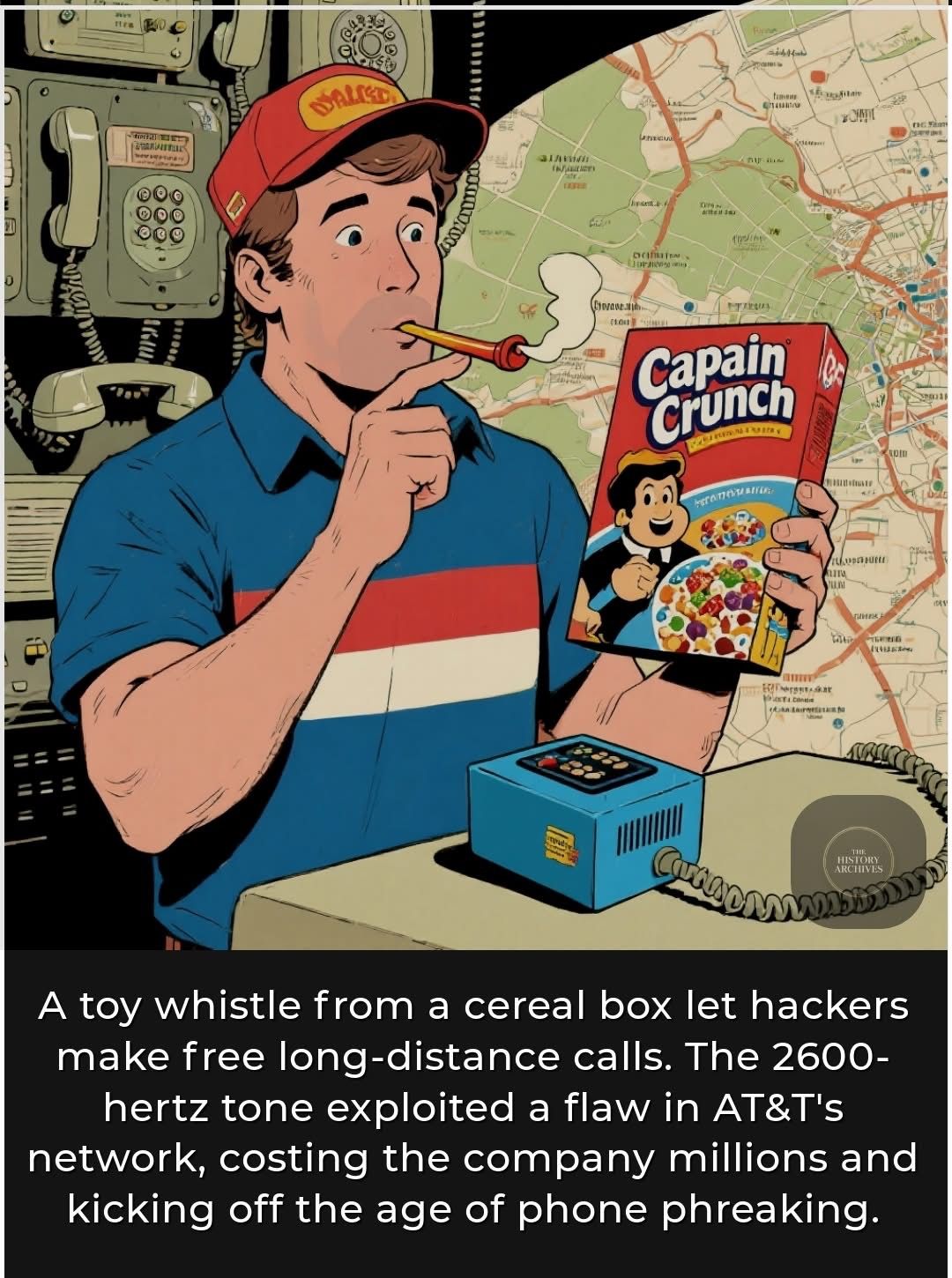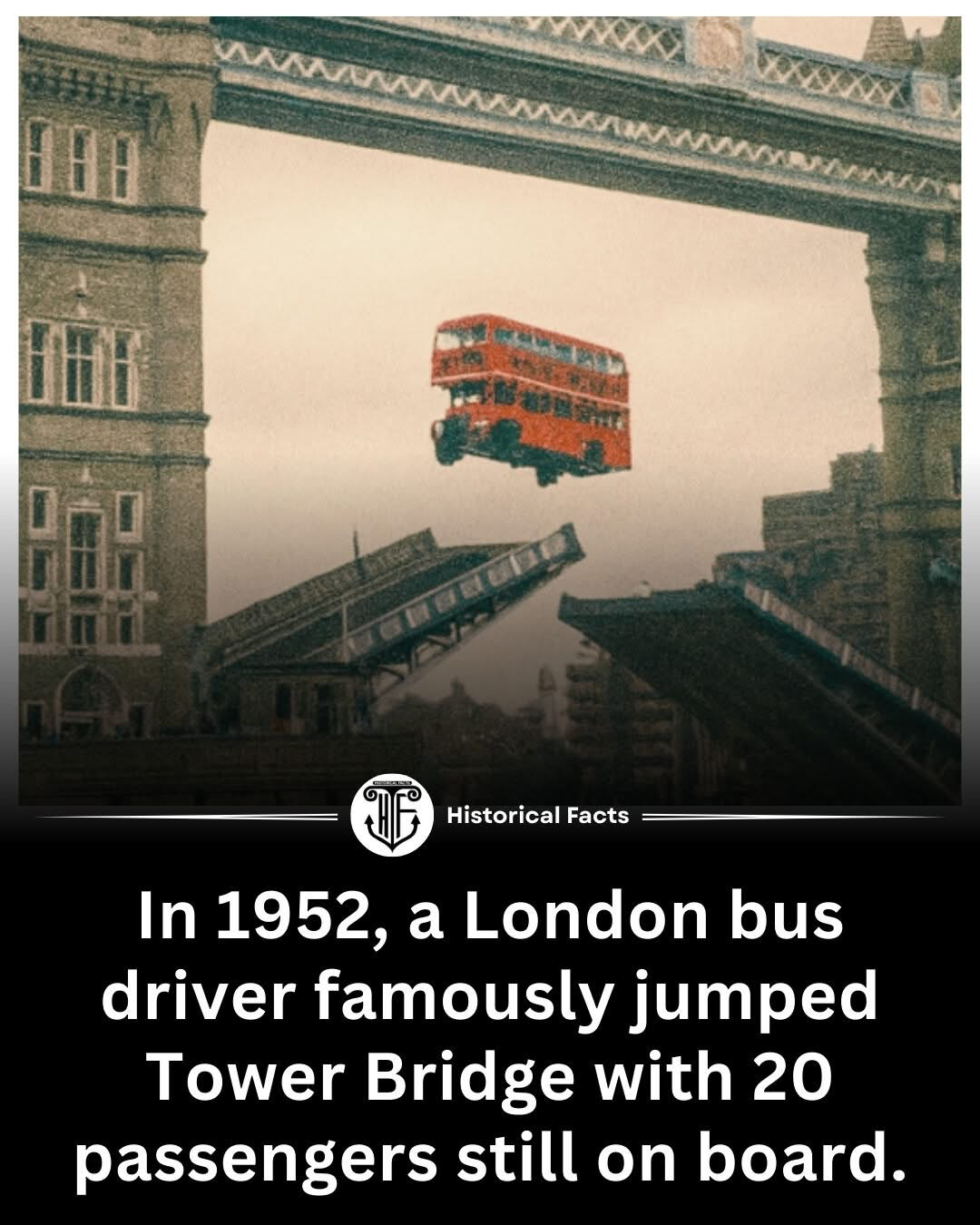Mildly interesting
-
Not to me it isn’t. You’re just so vulnerable. The slightest contact can be fatal, especially if you fall toward the road
@jon-nyc said in Mildly interesting:
Not to me it isn’t. You’re just so vulnerable. The slightest contact can be fatal, especially if you fall toward the road
I assume the numbers are US specific. I wonder what they are in countries with good bike infrastructure, like The Netherlands.
-

In the late 1960s, a simple toy whistle from a cereal box unlocked a world of free long-distance calls, leading to a revolution in telecommunications.

This story begins with a man named John Draper, who would later become famous in tech circles as “Captain Crunch.” He was a key figure in a community of early hackers known as “phone phreaks.”
While Draper didn't make the initial discovery, he popularized it. A friend told him that a toy whistle given away in boxes of Cap'n Crunch cereal could produce a perfect 2600-hertz tone.
This specific tone was a security key for the AT&T phone network. When played into a phone receiver, it tricked the system into thinking a long-distance call had ended, opening up the line for new routing commands.
This allowed a user with the right knowledge to make free calls anywhere in the world, essentially seizing control of the trunk lines that connected cities and countries.
Draper took the concept further. He created a device known as a “blue box,” an electronic gadget that could generate a wide range of tones to manipulate the phone network in even more complex ways.
This community of phreaks, including future tech giants like Apple’s founders Steve Wozniak and Steve Jobs, explored the vast, unseen infrastructure of the global phone system. 🥣
Their actions, while illegal, exposed major security flaws and forced telecommunication companies to build more secure digital networks, ushering in a new era of technology.
Sources: Wikipedia, IFL Science, Chaintech Network#PhonePhreaking #TelecomRevolution #HackerHistory
-

In 1952, London witnessed one of the most daring and extraordinary stunts in its history. Albert Gunter, a bus driver for the London Transport system, pulled off an unbelievable feat that would leave the city in awe. On a seemingly ordinary day, Gunter drove his double-decker bus straight toward Tower Bridge, but instead of stopping, he jumped the bus over the open bascule with 20 passengers on board.
The incident occurred when the drawbridge, designed to allow ships to pass along the Thames, was raised for a vessel. Rather than waiting or taking another route, Gunter made a split-second decision that defied all logic and safety. Remarkably, everyone on board survived the leap unscathed. The bus landed safely on the other side, and passengers were reported to be stunned but unharmed.
This audacious act became an instant legend, illustrating not only human courage but also the spirit of quick thinking and bold action in moments of crisis. While authorities investigated and safety measures were reinforced after the stunt, the event captured the imagination of Londoners and newspapers alike. Stories of Gunter’s bravery, or recklessness, depending on perspective, were recounted for decades as a symbol of daring adventure amidst the everyday routines of city life.
The bus jump over Tower Bridge remains one of the most astonishing public transport incidents in history, blending elements of risk, skill, and sheer nerve. It’s a reminder that sometimes extraordinary stories can happen in the most ordinary settings, turning a routine commute into a historic event that people would talk about for generations.
Fun Fact: Tower Bridge, completed in 1894, is one of London’s most iconic landmarks and was designed with a bascule system specifically to allow tall ships to pass along the Thames, making Gunter’s leap all the more incredible given the bridge’s engineering.
#HistoricalFacts #HistoryFacts #UKHistory #TimeTravel #DidYouKnow #TowerBridge #LondonHistory #DaringActs #BusDriverStunts #ExtraordinaryEvents
-
-
Same old argument, not all jobs are meant to be careers or primary income for adults.
-

The Ice-Cutters of the Great Lakes
Before the era of refrigeration, the harvesting of ice from the frozen Great Lakes was a massive, brutal industry. Each winter, crews of ice-cutters would venture onto the thick ice of lakes like Michigan and Erie. Using horse-drawn plows and massive saws, they would score the surface into a grid and cut huge, crystal-clear blocks. Men like "Big Jim" O'Malley, a foreman from Chicago, led teams that worked in sub-zero temperatures and blinding snow squalls, their beards frozen solid with ice. The blocks were then transported to massive, insulated ice houses lining the shores, where they were packed in sawdust to last through the summer. This ice would be shipped on specially designed ice barges to cities across the Midwest, preserving food and cooling drinks. It was dangerous work; men could easily slip into the freezing water or be crushed by shifting ice. O'Malley's saying was: "We're not just cutting ice; we're harvesting winter to make summer bearable." The industry vanished with modern refrigeration, but for a century, it was a vital part of the national economy.
-
@jon-nyc it’s astonishing how quickly they mature. We’ve had four sets of robin chicks hatch in our yard this year and secretly watching them go the through the surprisingly fast process was really interesting.
And yes, I’m old and boring now.
-

Goats have one of the most unique and functional eye shapes in the animal kingdom: rectangular pupils.
Unlike round or vertical pupils, these horizontal slits give goats a nearly 340° panoramic field of vision, allowing them to see almost everything around them without moving their heads.
This wide view is incredibly useful in the wild. As prey animals, goats are constantly on alert for predators. Their pupil shape helps them spot danger from almost any direction, even when their heads are lowered to graze. Remarkably, their eyes also rotate slightly to stay level with the horizon, giving them stable, clear vision even on steep, rocky slopes.
It’s a perfect example of form meeting function: those strange-looking eyes are a finely tuned survival tool.
 REFERENCE:
REFERENCE:
 Inside the Eye: Nature's Most Exquisite Creation (National Geographic)
Inside the Eye: Nature's Most Exquisite Creation (National Geographic) -

Who’s the greatest movie villain of all time? Forget Darth Vader. Forget Hannibal Lecter. Forget Voldemort. The real answer? Glinda — yes, Glinda the so-called “Good Witch” of the North. The one in the sparkly pink gown, smiling sweetly, pretending to be everyone’s friend. It’s always the ones with the tiaras you’ve got to watch out for.
Think about it. She shows up all floaty and radiant in her bubble like some kind of celestial savior, and within minutes she’s playing a game of cosmic chess where Dorothy is the disposable pawn. The poor girl has just been dropped into a land of technicolor nightmares, barely processing the fact that a house killed someone, and Glinda’s already scheming. First order of business? Magically slap those ruby slippers onto Dorothy’s feet. Without permission. No explanation, no warning, just — zap. And then, with a perfectly innocent smile, she casually drops the bombshell: “Oh, and by the way, you can’t take them off.” Convenient, right? Almost like she wanted the Wicked Witch of the West to lose her mind. Almost like she knew Dorothy was about to become a walking bullseye.
Then comes the kicker: Glinda sends this Kansas farm girl — armed with nothing but a dog, a picnic basket, and questionable footwear — on what is essentially a suicide mission. “Follow the yellow brick road,” she says, like it’s a Sunday stroll. No mention of flying monkeys. No mention of poison poppies. No mention of, oh, I don’t know, the murderous sorceress who now has a personal vendetta against her. Dorothy doesn’t need a travel itinerary; she needs a restraining order and maybe a Kevlar vest. But Glinda? She doesn’t care. As long as someone else handles the West Witch problem, she’s free to keep floating around in her glitter bubble, polishing her crown and humming lullabies to herself.
And here’s the real punch in the gut: Dorothy didn’t even need to go through any of it. Not the trek. Not the Wizard. Not the entire Technicolor death march. She could have clicked those heels and gone home from the start. But Glinda conveniently leaves that little detail out until Dorothy has risked life, limb, and sanity. Why? Maybe Glinda wanted her occupied. Maybe she needed a distraction. Or maybe — and this is where it gets delicious — she wanted the West Witch weakened, distracted, and ultimately destroyed, without lifting a perfectly manicured finger.
But you want real proof of Glinda’s dark side? Go back to their very first exchange. Dorothy, sweet, polite, Midwestern Dorothy, says: “I’ve never heard of a beautiful witch before.” Innocent, right? Glinda doesn’t miss a beat: “Only bad witches are ugly.” Read that again slowly. What she’s really saying is: good equals beautiful, bad equals ugly. And then, later, Glinda actually asks Dorothy, “Are you a good witch or a bad witch?” So, let’s unpack this. That means, in Glinda’s sparkly little worldview, if Dorothy were pretty, she wouldn’t even need to ask. But since she does ask, well… she clearly doesn’t find Dorothy’s looks reassuring. Yikes. Subtle, Glinda. Real subtle.
By the end, she sails back in like she’s been orchestrating this entire saga from her crystal ball. Smiles sweetly, waves her wand, and says, “Oh, silly me, you’ve had the power to go home all along.” And she has the audacity to act like she’s teaching Dorothy a valuable lesson about self-reliance, as though all those near-death experiences were some kind of personal growth seminar. No, Glinda. Dorothy didn’t need a lesson; she needed a straight answer and maybe a cup of tea.
So yes, while movie history loves to paint her as the benevolent fairy godmother, I’m not buying it. Behind that saccharine smile is the cold calculation of someone who knew exactly what she was doing. She wasn’t helping Dorothy. She was using her. The Wicked Witch of the West may have worn black and cackled like a Saturday morning cartoon villain, but Glinda? Glinda played the long game. The quiet ones always do.
And somewhere, high above Oz, she’s probably still floating in that ridiculous bubble, humming to herself, wondering how long it’ll take before anyone else catches on.
